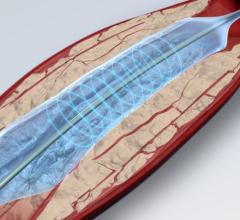January 3, 2008 - A patient’s physical activity status is a significant and robust predictor of all-cause mortality in patients with varying levels of ambulatory function, according to a new study that compares death rates between active and sedentary patients who have peripheral artery disease (PAD) with intermittent claudication published in the January 2008 issue of the Journal for Vascular Surgery.
PAD occurs in more than 20 percent of people over 70 years of age and is usually associated with high blood pressure, diabetes and stroke. It blocks the circulation to vital arteries most often in the legs and feet, and can cause difficulty in walking or even foot ulcers and infections.
However, some patients with PAD also develop intermittent claudication as they walk, resulting from a mismatch between reduced leg and foot circulation and the increased metabolic requirements necessary to walk or exercise.
Intermittent claudication affects five percent of people 55 years and older in the U.S., according to lead researcher Andrew W. Gardner, Ph.D., professor at the Clinical Research Center at the University of Oklahoma Health Sciences in Oklahoma City. “Ambulatory dysfunction limits physical activities of patients and negatively affects their lives,” he said. “As a result, many of these patients take on a sedentary lifestyle and become even more at risk for death.”
Researchers wanted to determine if physical activity can predict mortality in PAD patients and whether those limited by intermittent claudication could increase their life span by engaging in any amount of weekly physical activity compared to being sedentary or doing very light activities.
"We found that after adjusting for age, body mass index (BMI), ankle-brachial index results and other comorbidities, a patient’s physical activity status was a significant and robust predictor of all-cause mortality in patients with varying levels of ambulatory function,” said Dr. Gardner. "Even minimal amounts of physical activity performed at moderate intensity are beneficial and provide protective effects regardless of the ambulatory ability of patients limited by intermittent claudication."
"Incorporating less than one hour of walking each week at a speed faster than normal pace to reduce risk of death may apply equally well to patients who have severe intermittent claudication to those who have milder symptoms," added Dr. Gardner. "It is not clear whether moving faster than normal represents a threshold of intensity that must be attained to impact all-cause mortality, or whether this pace is beneficial simply because it results in a greater volume of physical activity. If the latter is true, it can be speculated that patients who walk at their usual pace, but for longer durations, may reduce their risk of an earlier death as well."
This retrospective study was done at the Geriatrics, Research and Clinical Center at the Maryland Veterans Affairs Health Care System in Baltimore between 1994 and 2002. One hundred and thirty-five physically active patients were compared with 299 patients in the sedentary group, and followed in the 2004 Social Security Death Index. Medical history, including physical function and activity, peripheral circulation, comorbid conditions and cardiovascular risk factors, were recorded for each patient. Additionally, a six-minute walk test was performed.
The median follow-up was 5.33 years for the physically active group, and five years for the sedentary group. One hundred and eight patients (24 percent) had died, consisting of 86 (28 percent) in the sedentary group and 22 (16.3 percent) in the active group.
Very few PAD patients limited by intermittent claudication walk fast, so the majority may have perceived that they performed activities at a moderate level of intensity simply by walking for any duration at a pace faster than normal. Patients classified themselves as being physically active when they did at least some of their activities at an intensity equivalent to fast walking, whereas the sedentary group said they avoid doing physical activity altogether or that they never exceed a light activity such as walking at a normal pace.
Other studies have shown that patients with intermittent claudication have a risk of mortality that is about two-fold higher than those without PAD. Prognosis for PAD patients generally worsens as the severity increases and studies have shown that asymptomatic patients have about half the all-cause mortality risk as those with intermittent claudication.
"The clinical implication of our findings is that PAD patients of varying ages, disease severity and body composition may reduce their heightened risk of mortality by engaging in less than one hour of physical activity each week that exceeds light intensity such as ambulating at speeds faster than their typical pace," added Dr. Gardner.
For more information: www.jvascsurg.org


 September 12, 2025
September 12, 2025 









